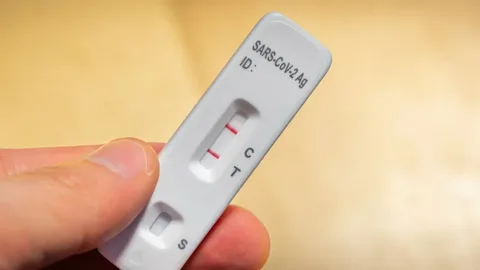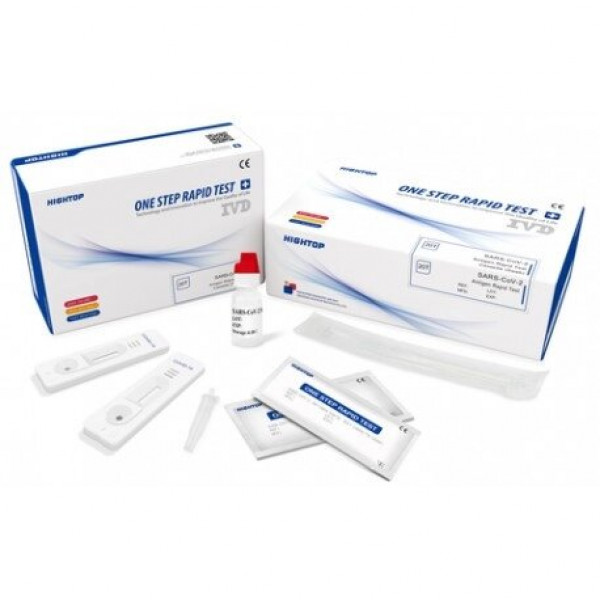Influenza, commonly known as the flu, is a highly contagious respiratory illness caused by influenza viruses. It can lead to serious complications and even death, especially in vulnerable populations such as young children, the elderly, and those with weakened immune systems. With the flu season approaching, it is important to have access to quick and accurate testing to detect and prevent the spread of the virus. This is where Influenza A/B test kits come into play – the fastest and most efficient way to diagnose flu infections. In this blog, we will discuss everything you need to know about these test kits and how they can help in the fight against the flu. So, let’s dive in and learn more about Influenza A/B test kits.
Understanding Influenza A and B: Know Your Enemy
When it comes to the flu, knowledge is power. Understanding the different strains of the virus can help us better prepare and protect ourselves. Influenza A and B are the two main types of influenza viruses that cause seasonal flu outbreaks. While both strains can cause similar symptoms, they have some distinct differences.
Influenza A is known for its ability to cause more severe and widespread outbreaks. It has multiple subtypes, classified based on the presence of two proteins on the surface of the virus – hemagglutinin (H) and neuraminidase (N). These subtypes, such as H1N1 and H3N2, can vary in their virulence and ability to spread. Influenza A viruses are typically associated with flu pandemics and can infect a wide range of hosts, including humans, birds, and pigs.
On the other hand, Influenza B viruses are usually less severe and tend to cause smaller, localized outbreaks. Unlike Influenza A, Influenza B viruses do not have subtypes but are divided into lineages, including Victoria and Yamagata. Influenza B viruses mainly infect humans and are not typically associated with pandemics.
So, why is it important to differentiate between Influenza A and B? Well, it helps in monitoring and predicting flu activity, determining vaccine composition, and providing appropriate antiviral treatment. This is where Flu A/B test kits come into play. These test kits can accurately identify the specific strain of the influenza virus, allowing healthcare professionals to take the necessary steps to control the spread of the flu.
Importance of Early Detection with Flu A/B Test Kits
Early detection is crucial when it comes to managing and preventing the spread of the flu. This is where Flu A/B test kits play a vital role. By providing quick and accurate results, these test kits allow healthcare professionals to identify flu infections at an early stage, leading to prompt treatment and control measures.
One of the key advantages of Flu A/B test kits is their ability to differentiate between Influenza A and B viruses. As mentioned earlier, these two strains have different characteristics and can cause varying degrees of severity in flu outbreaks. By accurately identifying the specific strain, healthcare professionals can better understand the nature of the flu outbreak and make informed decisions regarding treatment and prevention strategies.
How Do Influenza A/B Test Kits Work? An Inside Look
Flu A/B test kits are an essential tool in the fight against the flu. But how do these test kits actually work? Let’s take an inside look at their process.
Flu A/B test kits typically use a technique called polymerase chain reaction (PCR) to detect the presence of influenza viruses. This method involves amplifying and analyzing the viral RNA to determine whether the person being tested is infected with the flu.
The process begins with a swab sample collected from the patient’s respiratory system, usually from the nose or throat. This swab is then inserted into the test kit, where it comes into contact with specific reagents designed to target and amplify the viral RNA.
Next, the test kit goes through a series of heating and cooling cycles, which allows the viral RNA to be multiplied. This amplification process helps to ensure that even small amounts of the virus can be detected.
Once the viral RNA has been amplified, it is analyzed using fluorescent dyes or other detection methods. If the test kit detects the presence of either Influenza A or Influenza B, it will provide a positive result. If neither strain is detected, a negative result will be given.
Flu A/B test kits are known for their accuracy and speed. They can provide results within a matter of minutes, allowing healthcare professionals to quickly diagnose and treat flu infections.
Unveiling the Advantages of Using Flu A/B Test Kits
Flu A/B test kits offer numerous advantages in the fight against the flu. These innovative tools have revolutionized the process of diagnosing flu infections and have become an essential tool for healthcare professionals. Let’s explore some of the key advantages of using Flu A/B test kits.
- Rapid Results: One of the biggest advantages of Flu A/B test kits is their speed. These test kits can provide results within minutes, allowing for quick and accurate diagnosis. This rapid turnaround time is crucial in preventing the spread of the virus and initiating appropriate treatment measures promptly.
- Accuracy: Flu A/B test kits are highly accurate in detecting the presence of influenza viruses. With their ability to differentiate between Influenza A and B strains, healthcare professionals can gain valuable insights into the nature of the flu outbreak and make informed decisions regarding treatment and prevention strategies.
- Cost-Effective: Flu A/B test kits are a cost-effective solution for diagnosing flu infections. By providing quick and accurate results, these test kits reduce the need for unnecessary treatments and hospital visits, saving both time and money for patients and healthcare providers.
- Easy to Use: Flu A/B test kits are designed to be user-friendly and require minimal training to operate. This makes them accessible to a wide range of healthcare professionals, from doctors in clinics to nurses in remote areas. The simplicity of these test kits ensures that accurate results can be obtained even in resource-limited settings.
Practical Considerations when Purchasing Influenza A/B Test Kits
When it comes to purchasing Influenza A/B test kits, there are several practical considerations that should be taken into account. These considerations can help ensure that you are making the right choice and getting the most out of your investment in these valuable diagnostic tools.
First and foremost, it is important to consider the sensitivity and specificity of the test kit. Sensitivity refers to the ability of the test kit to accurately detect the presence of the influenza virus, while specificity refers to its ability to correctly identify individuals who are not infected. Ideally, you want a test kit that has high sensitivity and specificity, as this will ensure that you are getting reliable results.
Another important consideration is the ease of use of the test kit. Look for a kit that is user-friendly and requires minimal training to operate. This will ensure that healthcare professionals of all levels can easily use the kit and obtain accurate results.
Additionally, it is essential to consider the cost-effectiveness of the test kit. Compare the prices of different test kits and consider the long-term costs, including the need for additional supplies or reagents. Finding a cost-effective option will not only save you money but also allow for more widespread use of the test kits.
Finally, it is important to consider the availability and accessibility of the test kit. Look for a supplier or manufacturer that can provide reliable and timely delivery of the kits. Also, consider the accessibility of technical support or customer service, in case any issues or questions arise.
Using the Results of a Flu A/B Test Kit: What Next?
After receiving the results from a Flu A/B test kit, the next step is to take appropriate action based on the outcome. If the test indicates a positive result for either Influenza A or B, it is crucial to follow the recommended treatment plan provided by a healthcare professional. This may include antiviral medication, rest, and fluids to help manage symptoms and prevent complications.
In addition to individual treatment, it is important to take steps to prevent the further spread of the virus. This includes practicing good respiratory hygiene, such as covering your mouth and nose when coughing or sneezing, using tissues or the crook of your elbow. It is also advisable to stay home from work, school, or other public places to avoid exposing others to the virus.
For individuals who receive a negative result from the Flu A/B test kit, it is still essential to remain vigilant. The test may have been conducted too early in the infection, resulting in a false negative. If symptoms persist or worsen, it is recommended to consult with a healthcare professional for further evaluation.
Safety Measures while Handling Flu A/B Test Kits
When it comes to handling Flu A/B test kits, it is essential to prioritize safety to protect yourself and others. These test kits contain materials that may be potentially infectious, so following safety measures is crucial. Here are some important precautions to take when handling Flu A/B test kits:
- Personal Protective Equipment (PPE): Always wear appropriate PPE, including gloves, a lab coat or gown, and a face mask, when handling the test kits. This helps minimize the risk of contamination and ensures your safety.
- Proper Hand Hygiene: Before and after handling the test kits, make sure to thoroughly wash your hands with soap and water for at least 20 seconds. If soap and water are not available, use hand sanitizer with at least 60% alcohol content.
- Avoid Cross-Contamination: To prevent the spread of the flu virus, it is important to avoid cross-contamination between different samples. Use separate equipment, such as swabs, tubes, and pipettes, for each sample. Dispose of used materials properly according to biohazard waste disposal guidelines.
- Follow Instructions: Read and follow the instructions provided with the test kits carefully. This includes any storage or temperature requirements, as well as specific steps for sample collection and processing.
- Maintain a Clean Workspace: Keep your work area clean and organized. Disinfect the surface before and after use, and use disposable bench liners or absorbent pads to catch any spills or leaks.
Conclusion
In conclusion, Flu A/B test kits are an essential tool in the fight against the flu. These test kits provide quick and accurate results, allowing healthcare professionals to diagnose and treat flu infections promptly. By differentiating between Influenza A and B viruses, these test kits help in monitoring flu activity, determining vaccine composition, and implementing targeted prevention measures.
Flu A/B test kits offer numerous advantages, including rapid results, high accuracy, cost-effectiveness, ease of use, and early detection capabilities. These advantages make them an invaluable asset for healthcare professionals and contribute to reducing the overall burden of the flu.
When purchasing Flu A/B test kits, it is important to consider factors such as sensitivity, specificity, ease of use, cost-effectiveness, and accessibility. By making informed decisions, healthcare professionals can ensure that they are investing in reliable and efficient diagnostic tools.
| Other Good Articles to Read |
| Niche Blogs Connect |
| Blogs 97 |
| Blog Stitution |
| Blogs Unplugged |
| Blogs Cotch Rouge |
| Blog Signatr |
| Blog Sintonias |
| Blog Zilla |
| Consumer Forums |
| Finance Forums |
| G Blogs |
| Too Blog |



